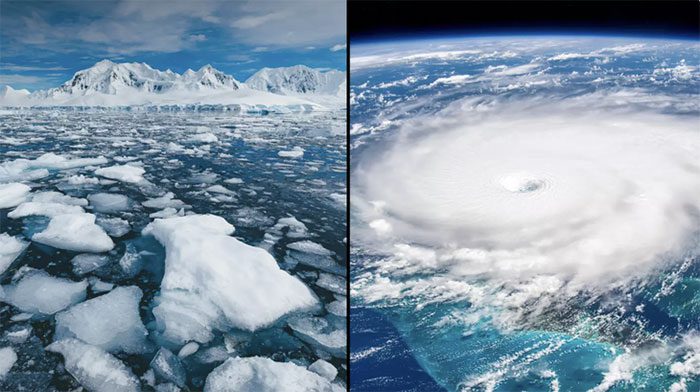This “super whirlpool” in Antarctica may have a significant impact on the fate of humanity, according to the latest scientific research just published.
The research indicates that Antarctica is facing serious trouble. A massive ocean whirlpool surrounding this continent appears to be accelerating and becoming more dangerous recently.
The Strongest “Super Whirlpool” on the Planet
The volume of this ocean whirlpool is over 100 times larger than that of all the rivers in the world combined. What might have caused this whirlpool? It could be due to climate change, scientists say.

The volume of the Antarctic ocean whirlpool is over 100 times larger than that of all the rivers in the world combined – (Photo: Ladbible.)
This conclusion is drawn from a new study that analyzed the activity of the Antarctic ocean whirlpool over the past 5.3 million years. The research utilized sediment cores taken from the most remote and rugged waters on Earth for analysis.
The ocean whirlpool, also known as the Antarctic Circumpolar Current (ACC), slows down during colder periods, such as during any ice age. Now, it is starting to accelerate in warmer weather, similar to the period we are currently in, due to global warming.
According to scientists at Columbia University in the United States, the scientific community is concerned that the increasing speed of the whirlpool is contributing to rising global sea levels as ice in Antarctica continues to melt.
Dr. Gisela Winckler, who works at the Lamont-Doherty Earth Observatory at Columbia and is a co-author of this new study, stated: “This is the strongest and fastest flow on the planet, considered the most important flow in the Earth’s climate system.”
She also added that these new findings mathematically link Antarctic ice to the flow rate of the Antarctic Circumpolar Current.
Global Warming as the Cause
Dr. Winckler referred to the new findings as “a scenario,” stating that “today we are observing global warming” through unusual phenomena on Earth, from the nearest areas to the most distant and remote regions.
Due to westerly winds, the Antarctic Circumpolar Current rotates clockwise around Antarctica at an average speed of 4 km/h, carrying about 169 million cubic meters of water per second. This water extends to the ocean floor and spans 2,000 km in width.
It is also believed that this whirlpool emerged when Antarctica separated from Australia 34 million years ago, during a period of significant tectonic movement on Earth. However, the current trend in the whirlpool’s activity only began around 12-14 million years ago.
Another study involving 40 scientists from 12 countries has been published in the journal Nature. Some of them boarded a drilling ship to collect sediment samples from the ocean floor.
At one point, the ship and crew faced waves higher than 18 meters, but they eventually succeeded in obtaining sediment samples. From there, scientists used X-ray techniques to analyze the changing sizes of the particles within.
Smaller particles settle more when the current is slower. Larger particles have enough weight to fall to the ocean floor as the Antarctic Circumpolar Current increases. The study revealed several periods where the flow rate of the Antarctic Circumpolar Current changed in accordance with significant global climate changes that we are aware of.
This new data was compared with previous studies conducted on the West Antarctic Ice Sheet, further demonstrating that periods of fast flow in the Antarctic Circumpolar Current coincide with times when ice in Antarctica shrinks.
Dr. Frank Lamy from the Alfred Wegener Institute in Germany, the lead author of the study, explained: “The reduction in ice volume may be due to increased heat transport southward. A stronger Antarctic Circumpolar Current means warmer deep waters are reaching the edge of the Antarctic ice shelves.”


















































